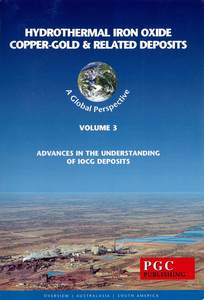Sources of ore fluid components in IOCG deposits
Williams, Patrick J., Kendrick, Mark A., and Xavier, Roberto Perez (2010) Sources of ore fluid components in IOCG deposits. In: Porter, T.M., (ed.) Hydrothermal Iron Oxide Copper-Gold & Related Deposits: a global perspective - advances in the understanding of IOCG deposits. Global Perspective Series, 3 . PGC Publishing, Linden Park, SA, Australia, pp. 107-116.
![[img]](https://researchonline.jcu.edu.au/18886/8.hassmallThumbnailVersion/18886_Williams_et_al__2010_Cover.jpg)
|
Image (JPEG) (Book Cover)
- Cover Image
Download (665kB) |
|
|
PDF (Published Version)
- Published Version
Restricted to Repository staff only |
Abstract
Many diverse hydrothermal copper deposits containing iron oxides are classified as IOCG deposits. Genetic models need to consider a number of different ore fluid components that may not all have the same source in an individual ore system, and also that economic IOCG deposits may include examples in which key components (especially copper) had different sources. The principal components of interest are: (I) water ± other volatiles, (2) chlorine, (3) sulphur, (4) iron, copper, gold (the diagnostic ore components), and (5) other potentially economic components (e.g. uranium) that may be differently-sourced to the copper and gold.
Geochemical studies are providing growing insights into source contributions to IOCG deposits, but their interpretation is commonly limited by inadequate baseline data for lithospheric to regional scale reservoirs and/or by incomplete understanding of natural fractionations that may affect the chemical systems. Where contributions from contemporary igneous rocks are evident, it is generally not clear whether these came directly from a volatile phase evolved from the magmas, or by leaching from previously consolidated rocks. Key aspects of current knowledge include: (I) IOCG deposits formed in a variety of different hydrological systems including (a) high level systems in which cool surficial fluids were able to interact with deeply-sourced fluids, and (b) deeper systems, some but not all of those for which suitable data are available, display evidence for a direct input of magmatic fluid; (2) Despite uncertainty about the compositions of source reservoirs and fractionations with silicate minerals, there is good evidence that many IOCG ore fluids had salinities derived from more than one source and that these were not the same in each case (e.g. ± magmatic, ± dissolved evaporite/meta-evaporite, ± evaporated surface water); (3) Only circumstantial evidence links the principal economic metals in IOCG deposits to any particular source such as (a) the correspondence of higher copper concentrations in those fluid inclusions from mineralised systems in the Cloncurry district that have Br/Cl ratios characteristic of a regional magmatic source, and (b) the correlation of copper endowment and contemporaneous mantle-derived REE in deposits in the Gawler craton. Many gaps still remain to be filled in the knowledge base for IOCG deposits and the potential sources of their components. Nevertheless there is already good evidence that there are fundamentally different genetic types of IOCG deposit.
| Item ID: | 18886 |
|---|---|
| Item Type: | Book Chapter (Research - B1) |
| ISBN: | 978-0-9871196-0-5 |
| Date Deposited: | 11 Oct 2011 03:55 |
| FoR Codes: | 04 EARTH SCIENCES > 0402 Geochemistry > 040201 Exploration Geochemistry @ 80% 04 EARTH SCIENCES > 0403 Geology > 040312 Structural Geology @ 20% |
| SEO Codes: | 84 MINERAL RESOURCES (excl. Energy Resources) > 8401 Mineral Exploration > 840102 Copper Ore Exploration @ 33% 84 MINERAL RESOURCES (excl. Energy Resources) > 8401 Mineral Exploration > 840104 Iron Ore Exploration @ 33% 84 MINERAL RESOURCES (excl. Energy Resources) > 8401 Mineral Exploration > 840105 Precious (Noble) Metal Ore Exploration @ 34% |
| Downloads: |
Total: 827 Last 12 Months: 15 |
| More Statistics |



